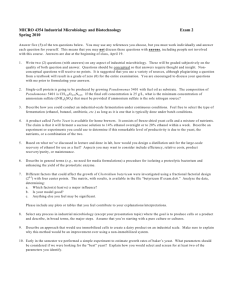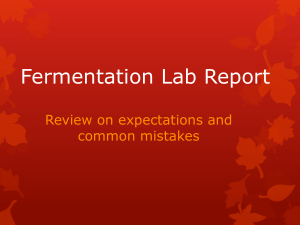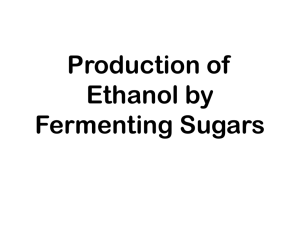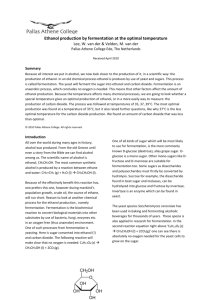Apresentação do PowerPoint
advertisement
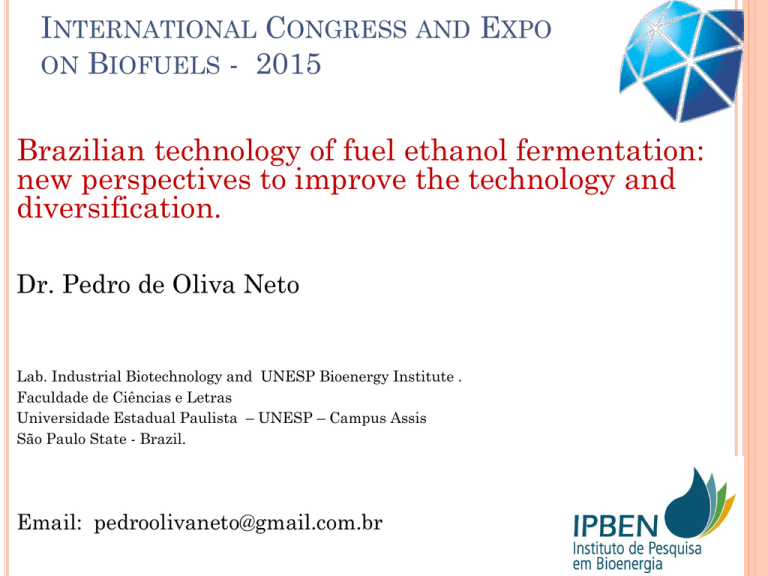
INTERNATIONAL CONGRESS AND EXPO ON BIOFUELS - 2015 Brazilian technology of fuel ethanol fermentation: new perspectives to improve the technology and diversification. Dr. Pedro de Oliva Neto Lab. Industrial Biotechnology and UNESP Bioenergy Institute . Faculdade de Ciências e Letras Universidade Estadual Paulista – UNESP – Campus Assis São Paulo State - Brazil. Email: pedroolivaneto@gmail.com.br OVERVIEW OF BRAZILIANS FUEL ETHANOL DISTILLERIES - Some current numbers of Ethanol Industry: The estimatation for the 2014/15 crop: - Cane Crop – 653 milh. Ton. (2% increase based on the last crop) - Sugar cane - 35.7 milh. ton. (0.8% increase based on the last crop) - Ethanol – 29.2 billion liters (2.8% increase based on the last crop) - The characteristic parameters of fermentation are: Ethanol efficiency (conversion of sugar to ethanol) - 90% to 92% ; Ethanol titles for fermented must : 8.0-10º GL; Fermentation times : 6 to 11 hours – 8 hs in a Fed-Batch process (more predominant process) Yeast concentration in the fermented must: 12-13% v /v; Final volume of liquid residue after distillation: 12-15 liters / liter of ethanol. Source: CONAB Brazil FLOWCHART OF BRAZILIAN ETHANOL AND SUGAR INDUSTRY Milling Cane washing Alkaline water (pH 11) Filtration (Static or Rotary vacuum cane mud) Filtered Broth return to clarification e Mud (fertilizer) Pre-heating (70oC) Bagasse (Burning in the boiler - Energy, steam) Heat treatment and decanting (Decanter 105oC/2 h) Clarification (SO2 and CaO addition) Phosphating Sugar manufacture Clarified broth Molasse (by-product of sugar manufacture) Dilution water and/or Clarified sugarcane juice Preparation of Wort (18-22o Brix - 30oC.) Yeast Acidification (pH 2.5) Hydro-alcoholic solution Distillation Acidification (H2SO4) of Yeast cells suspension return to fermentation Centrifugation Fermentation vat (pH 3.84.5, 32-34oC) (Fed-Batch, Continuous, Conbat or Batcon process) Fermented broth (Yeast 10-14%, ethanol 7.5-10% Residual sugar < 0.1%) Yeast cell suspension (40-80% wet mass) Oliva-Neto et al 2013. The Brazilian technology of fuel ethanol fermentation - yeast inhibition factors and new perspectives to improve the technology. In: A. Méndez-Vilas. (Org.). Materials and processes for energy: communicating current research and technological developments. 1 ed. Badajoz: Formatex, 2013, v. 1, p. 371-379. Important inhibitors of industrial fuel ethanol fermentation Biological contaminants: Yeasts: Flocculant S. cerevisiae, Dekkera, Brettanomyces ,Candida, Hansenula, Kloeckera, Kluyveromyces, Pichia, Rhodotorula, Schizosaccharomyces, Schwanniomyces, Torula, Torulopsis, Trichosporon, Cryptococcus . Problems: Decrease in ethanolic yield by sugar consume and yeast flocculation. Bacteria: The most important genus - Lactobacillus, Bacillus and Leuconostoc. species: Lactobacillus fermentum, L. plantarum The most important Problems: Sugar consumption producing lactic acid which decrease the yeast viability. Increase of yeast flocculation causing the yeast settling at the bottom of vats, and cell loss in centrifuges further contributing to the reduction in the ethanol yield. OLIVA-NETO, P.; YOKOYA, F. Evaluation of bacterial contamination in fed-batch alcoolic fermentation process. W. J. Microbiol. Biotechnol., v.10, p.697-699, 1994. OLIVA-NETO, P.; YOKOYA, F. Effects of nutricional factors on growth of Lactobacillus fermentum mixed with Saccharomyces cerevisiae in alcoholic fermentation. Rev. Microbiol, v.28, p.25-31, 1997 YOKOYA, F. ; OLIVA-NETO, P. Characteristics of yeast flocculation by Lactobacillus fermentum. Rev. Microbiol. São Paulo. v. 22, p. 21-27, 1991. ABIOTIC INHIBITORS OF YEAST FERMENTATION There important abiotic inhibitors are : a) The highest ethanol concentration used is 10% (v/v), The enzymes alcohol dehydrogenase and hexokinase are more sensitive to high concentrations of ethanol (Jones et al. 1976) b) pH and acidity - Acetic, formic and lactic acid have inhibitory effect by interfering in chemical maintenance functions of the cells, such as nutrient intake. Lactic acid shows inhibitory property in high concentrations (6-40 g/L) (Maiorella et al 1987, Oliva-Neto & Yokoya, 1994) pH in the industrial fermentation should be maintained higher than 4.0. Lower pH acting in a synergistic effect with other inhibitors and they affect the proton pump and other cellular functions of S. cerevisiae. (Dorta et al. 2006) c) Sulphite – Maximum level – 50 – 100 mg/L to avoid inhibition on the metabolism of sugar consumption. Sodium sulphite in the cane molasses - 200 to 700 mg/L, and in the wort up to 300 mg SO2/L. Dissulphite reacts with acetaldehyde and blocks NAD+ regeneration required for the glycolysis in yeast (Harada et al 1985, Alves, 1994). Sodium Sulphite MIC (Minimum Inhib.Concentr.) for S.cerevisiae is 5000 mg/L (OlivaNeto & Yokoya, 2001) d) High temperature – Maximum temperature possible to use in the fermentation is 34oC . Higher temperatures affect the cell membrane and yeast viability. DORTA et al. Synergism among lactic acid, sulfite, pH and ethanol in alcoholic fermentation of S. cerevisiae (PE-2 and M-26). World Journal of Microbiology & Biotechnology, England, v. 22, p. 177-182, 2006 Formulation of the fermentative media with stress factors: ethanol, lactic acid, sulphite and pH ______________________________________________________________________ sulfite (mg/L ) latic acid ethanol * pH toxicity Medium ToC (NaHSO3) (g/L) (%) level ______________________________________________________________________ 1 32 200 6.0 9.5 3.6 maximum 2 32 50 6.0 9.5 3.6 low sulfite 3 32 200 2.0 9.5 3.6 low lactic ac. 4 32 200 6.0 7.5 3.6 low ethanol 5 32 200 6.0 9.5 4.5 normal pH 6 32 0 0.0 7.5 4.5 control ____________________________________________________________________ * Sucrose at concentration of 16.37% or 20.65% (w/v) were used as carbon source; Cells morphology A - pH 4.5 – M 5 B - pH 3.6 –M1 Yeast budding and viabilitiy, residual protein and ethanolic yield in in medium after different fermentation conditions by Saccharomyces cerevisiae PE-2 ( ) and M-26 ( ). 35 70 30 60 Total turbidity average (600nm) Total turbidity average (600nm) S. cerevisiae cells flocculation by Lactobacillus fermentum 25 20 15 10 50 40 30 20 10 5 0 0 2 2 2,5 2,7 3 3,5 4 2,5 2,7 3 4,5 3,5 4 4,5 5 pH pH 0 0 175 min. 1360 min. 175 min. pH determination of 4650 UE Protease Novozyme 642 in deflocculation of Saccharomyces cerevisiae flocculated by Lactobacillus fermentum CCT 1396. pH determination of Carbohydrase SP 299 in deflocculation of Saccharomyces cerevisiae flocculated by Lactobacillus fermentum CCT 1396. Quantification of the yeast flocculation from induction by L. fermentum CCT 1396, after treatment with different concentrations of proteases and carbohydrases Flocs of S.cerevisiae and Lactobacillus Source: Fermentec Ludwig et al 2001 Rev. Soc. Brasileira Ciência e Tecnologia de Alimentos , v. 21, 1, p. 63-68. 5,5 The increase of yeast flocculation by the increase of L. fermentum Industrial Yeast Deflocculation – New perspectivies Yeast cell deflocculation on the S. cerevisiae suspension from fuel ethanol distillery treated with soluble papain in 15 minutes of reaction. Effect of the soluble and immobilized papain in the suspension of flocculated yeast from fuel ethanol distillery Yeast cell deflocculation with the recycle of soluble papain by centrifugation of yeast suspension and enzyme recovery SILVA et al 2015 Enzyme Research , v. 2015, Article ID 573721 Development of new chemicals for control of microbial infection in fuel ethanol fermentation. Minimum Inhibitory Concentration (MIC) for several chemicals against L.fermentum and S.cerevisiae, at 32oC - 24 h. ______________________________________________________________________________________________ Chemicals MIC (mg/l) Cultures _______________________________________________________________________________ S. cerevisiae 1 S.cerevisiae 2 L. fermentum1 L. fermentum 2 CCT 2652 FCLA M26 CCT 0559 CCT 1396 ______________________________________________________________________________________ TCC+CBe1 >12.5 12.5 6.25 6.25 TCC+CBe2 >12.5 >12.5 3.12 3.12 TCC+CBe3 >12.5 >12.5 6.25 6.25 TCC+CBa 5:12 >12.5 >12.5 6.25 6.25 TCC+CBa 2.5:12 >12.5 12.5 3,12 3,12 TCC+CBa 1:12 >12.5 12.5 1.56 1.56 TCC+ CBa 2.5:11 >12.5 >12.5 12.5 12.5 HJ Kamoran1 >0.312 >0.312 0.156 0.078 HJ Kamoran2 >0.625 >0.625 0.312 0.156 _______________________________________________________________________________________ Symbols: TCC - 3,4,4’ trichlorocarbanilide, CBe - benzethonium chloride, CBa - benzalkonium chloride, CTA – Cetyl trimethyl ammonium chloride. Hj Kamoran – commercial product (antibiotic Monensin). 1 - autoclavated product, culture in pH 6.0 for L.fermentum, 2 – microfiltered product, culture in pH 6.0 for L.fermentum, 3 – microfiltered product, culture in pH 4.0 for L.fermentum . - Oliva-Neto et al. 2014. Brazilian Archives of Biology and Technology. v. 57 (3), p. 441-447, 2014. Diversification of subtrates for ethanol fermentation: Search for more feedstocks and carbohydrases Amylases production and Residues for starch industry Effect of culture time on enzymatic activity (dashed line) of amylase in R. oryzae (dark circle) and R. oligosporus (white circle) cultures and medium final pH (solid line). Conditions: 30◦C, pH 5.5, wheat flour type II as substrate Enzymatic reaction using enzyme produced from R. oligosporus (1.25 U/mL) in 5% and 10% (w/v) starch solution at 50°C. Ethanolic efficiency from hydrolysis of cassava residue using R. oligosporus enzymes = 80% Freitas et al 2014 Chemical Papers, v. 68 (4) p. 442-450. Cellulases and Polygalacturonases produced in a Citrus residue (citrus pulp) culture medium in a cell recycle process A FPU /g Substrate 8 6 4 2 0 1 2 3 4 Cycle B B FPU / mL) 0.80 0.60 0.40 0.20 0.00 1 2 3 4 Cycle A. niger Poligalacturonase activity expressed (A) U/g and (B) U/ml in citric pulp culture of A. niger CCT 3312 and T. reesei QM 9414 with cell recycles of 72 h T. reesei Cellulase activity expressed (A) U/g and (B) U/ml in citric pulp culture of A. niger CCT 3312 and T. reesei QM 9414 with cell recycles of 72 h Barbosa, M.F. Shynia, T. Y. Oliva-Neto, P. Adding value to the citrus pulp by enzyme biotechnology. Lambert Academic Press. Saarbruchen. Germany. 52 p. 2014 Production of xylo-oligosacharides from bagasse XOS are Prebiotic: sugar oligomers that can not be digested by animals and humans. Advantages of prebiotics: - Increase the number of Probiotics in the gut. Decrease the number of harmful microbes. Improve the protection against osteoporosis, cardiovascular disease and colon cancer. Prevent dental caries. - Low calories. Animal nutrition: decrease the number of diseases and reduce use of antibiotics. Effect of temperature and pH of reaction for xylanase activity of A. fumigatus M51 on xylan Carvalho et al 2015. Food Technology and Biotechnology, v. 53, p. 1. Carvalho et al 2013 Food Research International, v. 51, p. 75-85. Collaborators: Dr. Ana Flávia Azevedo Carvalho – Postdoc student CNPq Ms Bruna Escaramboni - PhD student CNPq Ms. Tania Sila Campioni – PhD student CAPES Ms. Thaís Yumi Shinya – PhD student CAPES Fabiane Fernanda de Barros Correa – Masters student CNPq Douglas Fernandes da Silva – Doctoral student CNPq Louise Garbelotti Gonçalves - Master student CAPES Franciane Figueiredo – Master student CAPES UNESP
